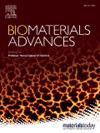Engineering a long-lasting microvasculature in vitro model for traumatic injury research
IF 6
2区 医学
Q2 MATERIALS SCIENCE, BIOMATERIALS
Materials Science & Engineering C-Materials for Biological Applications
Pub Date : 2025-04-09
DOI:10.1016/j.bioadv.2025.214310
引用次数: 0
Abstract
Microvascular injuries can have systemic physiological effects that exacerbate other injuries and pose a danger to life. Reliable in vitro microvascular models are required to enhance understanding of traumatic injuries. This research aims to develop and optimise a three-dimensional (3D) hydrogel construct for the formation and long-term stability of an in vitro microvascular model for trauma research.
First, we develop a 3D hydrogel scaffold using a physiologically relevant cell type to enable the formation of a durable microvascular endothelial network and validate it against the gold standard: HUVECs. Then, we explore the impact of modifying the hydrogel composition, specifically fibrinogen source and concentration, medium, and crosslinking ratio, on scaffold material properties and, consequently, the formation of endothelial networks, their architecture, and long-term integrity.
Our results demonstrate that 3D hydrogel scaffolds are crucial for maintaining network stability beyond the initial 24 h. For trauma research applications, the material properties and mechanical behaviour of the hydrogels are critical. Microrheometry revealed that fibrinogen concentration significantly influences gelation times, absorbance rate, storage modulus (G’), loss modulus (G”), and complex viscosity, while also reducing creep compliance.
Our multi-pronged approach to engineering microvasculature constructs revealed that variations in hydrogel composition, including fibrinogen concentration and source, crosslinking ratio and choice of medium, strongly affect the hydrogel material characteristics and, in turn, the resulting microvascular networks. Hydrogels made with high concentrations of human fibrinogen, a 200:10:1 crosslinking ratio, and endothelial basal medium (EBM) or EBM supplemented with VEGF performed best, demonstrating superior long-term network stability.
The microvasculature construct developed here could be used as a potential platform for studying traumatic injuries, as well as testing interventions aimed at improving recovery and mitigating damage.

为创伤研究设计长效微血管体外模型
微血管损伤可产生全身生理效应,加重其他损伤并危及生命。需要可靠的体外微血管模型来增强对创伤性损伤的认识。本研究旨在开发和优化三维(3D)水凝胶结构,用于创伤研究的体外微血管模型的形成和长期稳定性。首先,我们开发了一种3D水凝胶支架,使用一种生理上相关的细胞类型来形成持久的微血管内皮网络,并根据黄金标准:HUVECs对其进行验证。然后,我们探讨了改变水凝胶成分,特别是纤维蛋白原来源和浓度、介质和交联比例对支架材料性能的影响,从而影响内皮网络的形成、结构和长期完整性。我们的研究结果表明,3D水凝胶支架对于在最初的24小时内保持网络稳定性至关重要。对于创伤研究应用,水凝胶的材料特性和机械行为至关重要。微流变仪显示,纤维蛋白原浓度显著影响凝胶时间、吸光度、储存模量(G’)、损失模量(G’)和复合粘度,同时也降低了蠕变顺应性。我们多管齐下的工程微血管构建方法表明,水凝胶成分的变化,包括纤维蛋白原浓度和来源、交联比例和介质的选择,强烈影响水凝胶材料的特性,进而影响所产生的微血管网络。由高浓度人纤维蛋白原、200:10:1交联比例、内皮基础培养基(EBM)或添加VEGF的EBM制成的水凝胶表现最好,表现出优越的长期网络稳定性。这里开发的微血管结构可以作为研究创伤性损伤的潜在平台,以及测试旨在提高恢复和减轻损伤的干预措施。
本文章由计算机程序翻译,如有差异,请以英文原文为准。
求助全文
约1分钟内获得全文
求助全文
来源期刊
CiteScore
17.80
自引率
0.00%
发文量
501
审稿时长
27 days
期刊介绍:
Biomaterials Advances, previously known as Materials Science and Engineering: C-Materials for Biological Applications (P-ISSN: 0928-4931, E-ISSN: 1873-0191). Includes topics at the interface of the biomedical sciences and materials engineering. These topics include:
• Bioinspired and biomimetic materials for medical applications
• Materials of biological origin for medical applications
• Materials for "active" medical applications
• Self-assembling and self-healing materials for medical applications
• "Smart" (i.e., stimulus-response) materials for medical applications
• Ceramic, metallic, polymeric, and composite materials for medical applications
• Materials for in vivo sensing
• Materials for in vivo imaging
• Materials for delivery of pharmacologic agents and vaccines
• Novel approaches for characterizing and modeling materials for medical applications
Manuscripts on biological topics without a materials science component, or manuscripts on materials science without biological applications, will not be considered for publication in Materials Science and Engineering C. New submissions are first assessed for language, scope and originality (plagiarism check) and can be desk rejected before review if they need English language improvements, are out of scope or present excessive duplication with published sources.
Biomaterials Advances sits within Elsevier''s biomaterials science portfolio alongside Biomaterials, Materials Today Bio and Biomaterials and Biosystems. As part of the broader Materials Today family, Biomaterials Advances offers authors rigorous peer review, rapid decisions, and high visibility. We look forward to receiving your submissions!

 求助内容:
求助内容: 应助结果提醒方式:
应助结果提醒方式:


